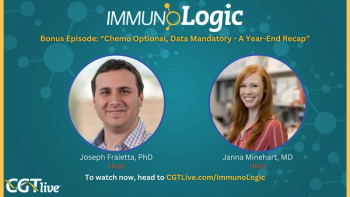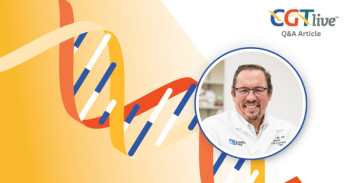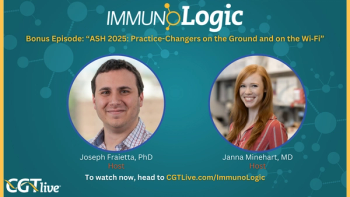
Finding the Immunotherapy Finish Line Remains a Challenge in NSCLC
Based on available data, treatment is not that obvious for patients with metastatic non–small cell lung cancer who are tolerating treatment well and have either a complete or partial response to therapy.
Gilberto Lopes, MD
Disease progression and toxicity are 2 benchmarks used to determine cutoff targets for treatment with PD-1 and PD-L1 inhibitors. What options are available for a patient with metastatic non—small cell lung cancer (NSCLC) who is tolerating treatment well and has either a complete or partial response to therapy? Based on available data, treatment options for those patients are not that obvious, according to Gilberto De Lima Lopes, MD.1
“What we have seen in the clinical trials is that we have either continued immunotherapy until disease progression or toxicity,” Lopes said in a presentation at the 17th Annual Winter Lung Cancer Conference®. “In the case of [trials conducted with] pembrolizumab [Keytruda], we have stopped at 2 years.”
The schema of clinical trials, particularly the primary endpoints, raise the question of what to do with patients who do not experience progression on treatment and who do not experience incidence of select toxicities. With respect to discontinuation due to toxicities, the ASCO guidelines recommend that grade 4 toxicities warrant permanent discontinuation of immune checkpoint inhibitors, with the exception of endocrinopathies that have been controlled by hormone replacement.2
Lopes, an associate professor of Clinical Medicine and associate director for Global Oncology at Sylvester Comprehensive Cancer Center, University of Miami Health System, summarized that based on the randomized trials conducted thus far, patients who remain on treatment at 1 year should continue treatment with a PD-1/PD-L1 inhibitor until disease progression, unacceptable toxicity, or until the 2-year mark is reached, at which point reassessment in consultation with the patient can take place.
Continuation of Therapy After 1 Year
The first randomized trial to evaluate the duration of a PD-1/PD-L1 therapy was the phase IIIb/IV CheckMate-153 trial (NCT02066636). Patients were given nivolumab (Opdivo) as monotherapy every 2 weeks for up to 1 year or until disease progression. Patients who completed 1 year of therapy were then randomly assigned to either continuous therapy or observation with the option to resume nivolumab at progression.
Of the 1245 patients treated, 220 remained on treatment at 1 year. Safety analysis was based on 107 patients randomized to the continuous treatment and 113 patients in the discontinuation arm.
Those who continued on nivolumab had an improvement in progression-free survival versus those who stopped therapy (not reached [NR] vs 10.3 months; HR, 0.42; 95% CI, 0.25-0.71). A nonsignificant trend for overall survival (OS) was also observed (NR vs 23.2 months; HR, 0.63; 95% CI, 0.33-1.20).3
At the time of randomization, 87 patients in the discontinuation arm had response or stable disease. Forty-three (49%) patients had disease progression after discontinuation and 79% (34/43) were retreated with nivolumab. The median duration between progression and retreatment was 0.6 months (range, 0.1-4.9) and the median duration of retreatment was 3.8 months (range, 0.1-17.5).3
“These [data] answer the question, at least for now, that 1 year [with nivolumab] is probably not enough,” Lopes said. “Would I stop at 1 year? Only if there is good reason.”
Stopping Treatment After 2 Years
Long-term follow-up data from the KEYNOTE-10 trial (NCT01905657) demonstrated that patients who completed 2 years of pembrolizumab had a durable response—including in patients who discontinued treatment—and adverse events that were manageable.4 Patients were randomized 1:1:1 to receive pembrolizumab at 2 mg/kg or 10mg/kg for 24 months versus docetaxel. All patients had a PD-L1 tumor proportion score ≥1%. The median treatment duration was 3.5 months (range, 0.03-31.7) in the pembrolizumab arms (n = 682) versus 2.0 months (range, 0.03-26.4) in the docetaxel group (n = 309). “Most of our patients are not benefitting,” Lopes noted, adding that improvements are needed in second-line treatment options.
Seventy-nine patients completed 2 years of pembrolizumab with a median follow-up of 43.4 months (range, 35.7-49.8). Of those patients, 95% (75/79) had an ongoing response and the median duration of response was not reached (NR; range, 4-46+). The median OS was also NR.
“Patients who completed 2 years of pembrolizumab had a very good prognosis because they were selected for being responders,” Lopes added.
After discontinuation, 64% of patients demonstrated an ongoing response and nearly half (43%) of the patients who went on to rechallenge with pembrolizumab following progression had a second response. “Importantly, among patients who stopped [treatment with pembrolizumab] and then progressed, 14 patients did get a second course of pembrolizumab and of those patients, 43% had a partial response and 36% had stable disease; so, we do salvage some patients if they have been on immunotherapy for 2 years.”
How Will We Learn to Stop?
Despite some data, the lingering question is how to determine the best time to discontinue treatment. Lopes shared that at this juncture, the patient may play a role in deciding the next step of their treatment. “Usually what happens is I will talk to a patient who is approaching 2 years [on immunotherapy] if they still have a continued response or stable disease,” Lopes said. “The results are mixed. One patient may say, ‘You tell me what to do, doc.’ But typically, we have a short discussion with the data I have just shown you and about half of my patients elect to continue [therapy] and half want to stop.”
Longer trials evaluating the safety and efficacy of immune checkpoint inhibitors given continuously versus intermittently are needed in the lung cancer space. Lopes pointed to the STOP-GAP (NCT02821013) trial evaluating continuous therapy with a PD-1 inhibitor in metastatic melanoma with a 7-year time frame as an example.
References
- de Lima Lopes G. When to stop immunotherapy. Presented at: 17th Annual Winter Lung Cancer Conference; February 7-9, 2020; Miami Beach, FL.
- Brahmer JR, Lacchetti C, Thompson JA. Management of immune-related adverse events in patients treated with immune checkpoint inhibitor therapy: American Society of Clinical Oncology Clinical practice guideline. J Oncol Pract. 2018;14(4):247-249. doi: 10.1200/JOP.18.00005.
- Spigel DR, McCleod M, Hussein MA, et al. CheckMate153: randomized results of continuous vs 1-year fixed duration nivolumab in patients with advanced non-small cell lung cancer. Ann Oncol. 2017;28(suppl 5; abstr 1297O).
- Herbst RS, Garon EB, Kim DW, et al. Long-term survival in patients (pts) with advanced NSCLC in the KEYNOTE-010 study overall and in pts who completed two years of pembrolizumab (pembro). Ann Oncol. 2018;29(suppl 8; abstr LBA63). doi: 10.1093/annonc/mdy424.075.
Newsletter
Stay at the forefront of cutting-edge science with CGT—your direct line to expert insights, breakthrough data, and real-time coverage of the latest advancements in cell and gene therapy.





































